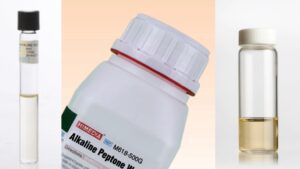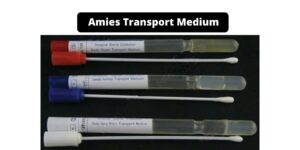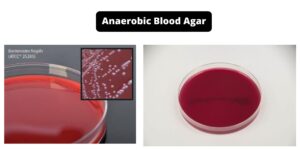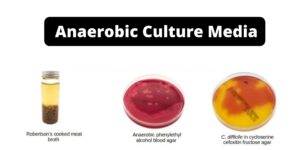What is Bird Seed Agar (Staibs Medium)?
- This modification enhanced the medium’s selectivity, making it more effective in isolating Cryptococcus neoformans. The antimicrobial additive helps to inhibit the growth of other microorganisms, allowing for the selective growth of Cryptococcus species.
- The original formulation of bird seed agar, developed by Staib in 1962, utilized Guizotia abyssinica seeds as the primary ingredient. These seeds were found to contain caffeic acid, which acted as a substrate for the production of melanin by Cryptococcus neoformans. Melanin synthesis is an essential characteristic of this yeast species, and it plays a crucial role in its pathogenicity.
- When grown on bird seed agar, Cryptococcus neoformans forms brown pigmented colonies due to the production of melanin. This distinctive colony coloration allows for easy differentiation of Cryptococcus neoformans from other species. The selective and differential properties of bird seed agar make it an invaluable tool in clinical laboratories for the identification and isolation of Cryptococcus neoformans.
- Bird seed agar has been further referred to by various names, including Caffeic Acid Agar, Niger Seed Agar, and Staib Agar. These alternative names reflect the presence of caffeic acid in the medium and its importance in melanin production by Cryptococcus neoformans.
- In summary, Bird Seed Agar, or Staib medium, is a specialized culture medium used for the selective isolation and differentiation of Cryptococcus neoformans from clinical specimens. Its unique formulation, containing Guizotia abyssinica seeds or caffeic acid, allows for the growth and visualization of brown pigmented colonies characteristic of Cryptococcus neoformans. The modification of bird seed agar by Shields and Ajello added selectivity through the use of an antimicrobial additive, further enhancing its utility in the laboratory setting.
Principle of Bird Seed Agar
The principle of Bird Seed Agar revolves around its composition and the reactions it facilitates to selectively identify and differentiate Cryptococcus neoformans. The key components of the agar are Guizotia abyssinica seeds, creatinine, dextrose, and an antibiotic.
Guizotia abyssinica seeds provide essential nutrients for the growth of Cryptococcus neoformans. The seeds contain caffeic acid, which serves as a substrate for the detection of phenoloxidase, an enzyme produced by C. neoformans. Phenoloxidase acts on caffeic acid, leading to the production of melanin. Melanin is then absorbed by the yeast cell wall, resulting in the formation of tan to reddish-brown pigmentation. This melanization process is a characteristic feature of Cryptococcus neoformans and aids in its identification.
Dextrose in the medium serves as the energy source for the growth of the yeast. It provides the necessary carbohydrates to support the metabolic activities of Cryptococcus neoformans.
Creatinine, another component of Bird Seed Agar, enhances the melanization of certain strains of Cryptococcus neoformans. It promotes the production of melanin and contributes to the visual differentiation of the yeast on the agar medium.
To prevent the overgrowth of bacteria and rapidly growing molds that can overshadow the growth of slow-growing dimorphic fungi like Cryptococcus neoformans, an antibiotic is added to the Bird Seed Agar. Commonly used antibiotics include chloramphenicol, which inhibits the growth of bacteria and molds, ensuring the selective growth of Cryptococcus species.
Agar, the solidifying agent, provides a solid surface for the growth of microorganisms. It allows for the formation of distinct colonies and facilitates the handling and observation of the cultures.
Intended Use
Used for selective isolation and differentiation of Cryptococcus neoformans from other Cryptococcus and other yeasts.
Composition of Bird Seed Agar
| Ingredients | Gm / Litre |
| Guizotia abyssinica seeds | 70g |
| Creatinine | 0.780g |
| Dextrose | 10g |
| Chloramphenicol | 0.050g |
| Agar | 20g |
Final pH 6.5 +/- 0.3 at 25ºC.
Additives: to each 500 ml bottle.
- Penicillin G (20 units/ml) 1 mL
- Gentamicin (40 mg/ml) 1 mL
Preparation of Bird Seed Agar
The preparation of Bird Seed Agar involves several steps to ensure the proper incorporation of the ingredients and the sterilization of the medium. The following is a general outline of the preparation process:
- Start by grinding the seeds of Guizotia abyssinica into a fine powder.
- Take 1000 ml of distilled water and mix it with the ground seeds. Stir well to ensure proper dispersion.
- Boil the mixture for approximately 30 minutes. This boiling process helps extract the necessary components from the seeds. After boiling, the mixture needs to be filtered to remove any solid particles. Pass the mixture through filter paper, collecting the filtrate.
- Adjust the volume of the filtrate to 1000 ml. This adjustment may involve adding more distilled water to reach the desired volume.
- Add the remaining ingredients to the filtrate, including creatinine and dextrose. Stir the mixture thoroughly to dissolve all the ingredients.
- The medium is now ready for sterilization. Place the mixture in a container suitable for autoclaving.
- Autoclave the Bird Seed Agar at 110°C for 15-20 minutes. Autoclaving ensures the complete sterilization of the medium, eliminating any potential contaminants.
- After sterilization, allow the medium to cool to approximately 48°C. This temperature is suitable for microbial growth without causing damage to the organisms.
- Add 0.5 ml of Penicillin G and 0.5 ml of Gentamicin to each 500 ml of Bird Seed Agar. These antibiotics help prevent the overgrowth of bacteria and molds, ensuring selective growth.
- Gently mix the agar to ensure proper distribution of the antibiotics.
- Finally, pour the prepared Bird Seed Agar into sterile petri dishes. Allow the agar to solidify before use.
Test Procedure of Bird Seed Agar (specimen/organism inoculation)
The test procedure for Bird Seed Agar involves specimen or organism inoculation onto the agar plates and subsequent incubation. Here is a general outline of the test procedure:
- Allow the Bird Seed Agar plates to warm to room temperature or 37°C, depending on the specific requirements. This ensures that the temperature of the agar surface is suitable for inoculation.
- Before inoculation, allow the surface of the agar to air dry. This step helps prevent excess moisture on the surface, which can interfere with proper streaking and isolation of colonies.
- Take a sterile plate for the inoculation. Ensure that the plate is labeled appropriately for identification and traceability.
- If the specimen to be cultivated is on a swab, gently place the swab on a small portion of the agar surface. It is important to only touch a small area to ensure proper isolation and growth of colonies.
- If streaking to isolate the specimen, use an unsterile loop or a sterile inoculation loop. Streak the specimen in a pattern that allows for the isolation of individual colonies. This technique helps obtain pure cultures for further analysis.
- After inoculation, close the agar plate and ensure proper sealing to maintain a sterile environment.
- Incubate the plate aerobically at 30°C. This temperature provides optimal conditions for the growth of Cryptococcus neoformans and other related species.
- Incubate the plates for a specified duration, which is usually seven days. This incubation period allows sufficient time for the colonies to develop and exhibit characteristic features.
- After incubation, carefully review the colony characteristics. Observe the color, texture, shape, and any other distinguishing features. Pay specific attention to the pigmentation of the colonies, as this is crucial in differentiating Cryptococcus neoformans from other species.
Result Interpretation of Bird Seed Agar
The interpretation of results obtained from Bird Seed Agar involves the observation of colony characteristics after incubation of the plates at 30°C for 2 weeks. The following information can be used as a guide for result interpretation:
- Positive Result: If brown to black pigmented smooth colonies are observed on the agar, it indicates a positive result. This characteristic colony appearance is indicative of the presence of Cryptococcus neoformans. Cryptococcus neoformans is known to produce melanin, resulting in the development of golden brown to black pigmented colonies on the medium.
- Negative Result: If non-pigmented colonies are observed on the agar, it suggests a negative result. Species such as Cryptococcus laurentii, Saccharomyces cerevisiae, and others typically produce non-pigmented colonies on Bird Seed Agar. These colonies will lack the characteristic brown to black pigmentation seen in Cryptococcus neoformans.
- Candida: Candida species, which can also be present in clinical samples, typically appear as white colonies on Bird Seed Agar. They do not produce pigmentation like Cryptococcus neoformans or other non-pigmented species.

Storage and Shelf life of Bird Seed Agar
Bird Seed Agar should be stored under specific conditions to maintain its quality and extend its shelf life. Here are the guidelines for the storage and shelf life of Bird Seed Agar:
- Storage Temperature: Bird Seed Agar should be stored at a temperature range of 2-8°C (36-46°F). It is important to keep the medium within this temperature range to prevent any changes or degradation in its composition.
- Protection from Light: Bird Seed Agar is light-sensitive and should be protected from direct light exposure. Light can potentially affect the stability and performance of the medium. Therefore, it is recommended to store Bird Seed Agar in a dark or opaque container to minimize light exposure.
- Protection from Excessive Heat: It is essential to protect Bird Seed Agar from excessive heat. High temperatures can lead to the melting or softening of the agar, resulting in a loss of its solidifying properties. Avoid storing Bird Seed Agar in locations where it may be exposed to excessive heat sources.
- Protection from Moisture: Moisture can impact the integrity and quality of Bird Seed Agar. To ensure its longevity, store the medium in a dry environment and protect it from moisture or humidity. Moisture can lead to the growth of microorganisms or cause changes in the agar’s consistency.
- Protection from Freezing: Bird Seed Agar should be protected from freezing temperatures. Freezing can cause irreversible damage to the medium, resulting in changes in texture and performance. Avoid storing Bird Seed Agar in freezers or areas prone to freezing.
- Shelf Life: The shelf life of Bird Seed Agar depends on the manufacturer’s specifications. It is important to check the expiration date provided by the manufacturer and follow their recommendations regarding shelf life. Discard any Bird Seed Agar that shows signs of degradation, such as shrinking cracks, cracks, discoloration, or contamination.
Uses of Bird Seed Agar
Bird Seed Agar has several important uses in the field of microbiology, particularly in the identification and isolation of Cryptococcus neoformans. Here are the key uses of Bird Seed Agar:
- Selective Isolation of Cryptococcus neoformans: Bird Seed Agar is primarily used for the selective isolation of Cryptococcus neoformans from various clinical and environmental samples. The agar medium contains specific components that promote the growth and differentiation of Cryptococcus neoformans while inhibiting the growth of other microorganisms. This selectivity allows for the isolation of Cryptococcus neoformans colonies for further analysis.
- Differentiation of Cryptococcus Species: Bird Seed Agar helps differentiate Cryptococcus neoformans from other yeasts, including different species of Cryptococcus. The medium provides specific conditions that allow Cryptococcus neoformans to produce distinctive brown to black pigmented colonies due to the melanin synthesis process. This differentiation aids in the accurate identification of Cryptococcus neoformans and distinguishes it from other species that may be present in the sample.
- Clinical and Environmental Sample Analysis: Bird Seed Agar is particularly useful for the analysis of clinical samples and environmental sources suspected to contain Cryptococcus neoformans. Clinical samples can include specimens such as cerebrospinal fluid (CSF), respiratory secretions, or skin scrapings, while environmental samples can include bird droppings, soil, or decaying organic matter. By inoculating these samples onto Bird Seed Agar, it becomes possible to selectively isolate and identify Cryptococcus neoformans, aiding in the diagnosis and understanding of cryptococcal infections.
Limitations of Bird Seed Agar
Bird Seed Agar, despite its usefulness in the selective isolation and differentiation of Cryptococcus neoformans, does have some limitations. Here are the main limitations associated with the use of Bird Seed Agar:
- Pigmentation Variability: While Bird Seed Agar is designed to promote the development of pigmented colonies by Cryptococcus neoformans, it is important to note that rare strains of this organism may not produce pigmented colonies. Some strains of Cryptococcus neoformans may lack the phenoloxidase activity necessary for melanin synthesis, resulting in colonies that appear non-pigmented. This can lead to challenges in the accurate identification of Cryptococcus neoformans solely based on pigmentation.
- Bacterial Contamination: When specimens are heavily contaminated with bacteria, the growth and pigmentation of Cryptococcus neoformans can be obscured. Bacterial overgrowth can overtake the culture, making it difficult to identify the characteristic pigmented colonies of Cryptococcus neoformans. This limitation highlights the importance of properly handling and processing specimens to minimize bacterial contamination.
- Pigmentation by Other Organisms: Bird Seed Agar may support the growth of certain organisms, such as Aureobasidium, Sporothrix, Wangiella, and Phialophora, that can produce dark brown colonies. However, the pigment produced by these organisms is not a result of the same enzymatic activity as seen in Cryptococcus neoformans. This means that the pigmentation observed in colonies on Bird Seed Agar may not be specific to Cryptococcus neoformans, leading to potential misinterpretation of results.
- Cross-Checking with Other Media: To address the limitations and ensure accurate identification, it is important to compare the growth and pigmentation of organisms on Bird Seed Agar with growth on other media, such as Sabouraud Dextrose agar. This cross-checking helps verify if the observed pigmentation is a natural characteristic of the organism or if it is specific to the growth conditions provided by Bird Seed Agar.
Quality control
Quality control is an essential aspect of using Bird Seed Agar to ensure its reliability and performance. Here are the key quality control measures and parameters used to assess the agar:
- Appearance: Bird Seed Agar should appear as light yellow to light brown hygroscopic soft lumps that can be easily broken down into powder. Any abnormal appearance, such as discoloration or irregular texture, may indicate a quality issue.
- Gelling: The agar should form a firm gel comparable to a 2.0% Agar gel. This ensures that the agar has the appropriate consistency for proper growth and isolation of microorganisms.
- Colour and Clarity: When prepared and poured into Petri plates, Bird Seed Agar should form a medium amber-colored opalescent gel. This indicates the correct formulation and uniform distribution of components.
- pH: The pH of a 10.1% w/v aqueous solution of Bird Seed Agar at 25°C should be within a range of 6.7±0.2. Maintaining the proper pH level is crucial for the growth and differentiation of specific microorganisms.
- Cultural Response: Specific organisms are used as quality control strains to assess the cultural response of Bird Seed Agar. For example, Cryptococcus neoformans ATCC 32045 should demonstrate good growth with a brownish-yellow pigment, while Staphylococcus aureus ATCC 25923 should show inhibited growth.
- Organism Inoculum (CFU): The specified inoculum size, measured in colony-forming units (CFU), is used to ensure that the agar supports the appropriate growth of microorganisms.
FAQ
What is Bird Seed Agar?
Bird Seed Agar, also known as Staib medium or Caffeic Acid Agar, is a solid culture medium used for the selective isolation and differentiation of Cryptococcus neoformans from clinical and environmental samples.
What are the key components of Bird Seed Agar?
The main components of Bird Seed Agar include Guizotia abyssinica seeds (or caffeic acid), creatinine, dextrose, an antibiotic (such as chloramphenicol), and agar as the solidifying agent.
How does Bird Seed Agar selectively isolate Cryptococcus neoformans?
Bird Seed Agar selectively isolates Cryptococcus neoformans by providing nutrients for its growth while inhibiting the growth of other microorganisms. It also contains components that promote melanin synthesis, resulting in distinctive pigmentation in Cryptococcus neoformans colonies.
Can Bird Seed Agar be used for species other than Cryptococcus neoformans?
While Bird Seed Agar is primarily used for Cryptococcus neoformans, it may also support the growth of other fungi, such as Aureobasidium, Sporothrix, Wangiella, and Phialophora. However, the pigmentation produced by these organisms is different from that of Cryptococcus neoformans.
What is the incubation temperature and duration for Bird Seed Agar?
Bird Seed Agar plates are typically incubated aerobically at 30°C for a duration of two weeks to allow sufficient time for the growth and pigmentation of Cryptococcus neoformans colonies.
What does a positive result on Bird Seed Agar indicate?
A positive result on Bird Seed Agar is indicated by the development of brown to black pigmented smooth colonies, which are characteristic of Cryptococcus neoformans.
Are there any limitations to using Bird Seed Agar?
Yes, Bird Seed Agar has limitations. For instance, rare strains of Cryptococcus neoformans may not produce pigmented colonies, heavily contaminated specimens can obscure the growth and pigmentation, and other organisms may produce dark brown colonies but without the same enzymatic activity as Cryptococcus neoformans.
How should Bird Seed Agar be stored?
Bird Seed Agar should be stored at a temperature range of 2-8°C, protected from direct light, excessive heat, moisture, and freezing. It is important to follow the manufacturer’s instructions for proper storage.
What is the shelf life of Bird Seed Agar?
The shelf life of Bird Seed Agar depends on the manufacturer’s specifications. It is important to check the expiration date provided by the manufacturer and avoid using the medium if there are any signs of degradation or contamination.
Can Bird Seed Agar be used as the sole medium for identifying Cryptococcus neoformans?
While Bird Seed Agar is a useful medium for the selective isolation and differentiation of Cryptococcus neoformans, it is recommended to compare the growth and pigmentation with other media, such as Sabouraud Dextrose agar, to confirm the presence of Cryptococcus neoformans and ensure accurate identification.
References
- https://himedialabs.com/TD/M675.pdf
- https://assets.thermofisher.com/TFS-Assets/LSG/manuals/IFU8172.pdf
- https://www.adelaide.edu.au/mycology/laboratory-methods/bird-seed-agar
- https://microbeonline.com/bird-seed-agar-principle-composition-uses/



